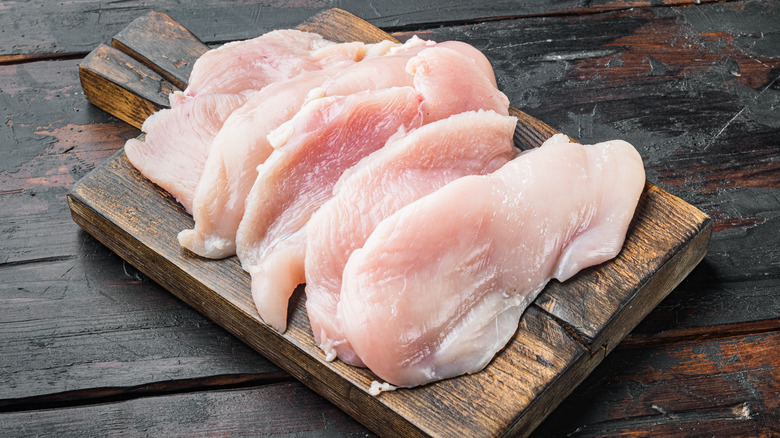What Lab-Grown Chicken Actually Tastes Like
As we navigated through grocery store aisles full of the plant-based fake meat that gained popularity in the early aughts, scientists were busy creating a new meat alternative in labs: cultivated real meat. In 2016, Upside Foods, the world's first cultivated meat company, successfully created the first-ever lab-grown beef meatball. A year later, they cultivated chicken and duck meat as well. Fast-forward to 2023, the US Department of Agriculture cleared their lab-grown chicken to be sold in the United States.
Researcher Willem Frederik van Eelen was the first person to pioneer the idea of cultured meat in the 90s. Instead of feeding pellets and mash to live chickens only to slaughter them when they're big enough, lab-grown chicken is made by feeding chicken cells a brothy mixture of ingredients including sugars, vitamins, amino acids, minerals, and salt to let them grow into meat fit for human consumption. The process, which requires no injury to the animal — the cells can be taken from a fertilized egg — takes about two or three weeks.
Now that we've somewhat tackled the how, let's get to another question that naturally comes to mind when we think about lab-grown chicken: What does it taste like, really? As it turns out, lab-grown chicken tastes and feels like the real thing, texture and all. "The most common response we get is, 'Oh, it tastes like chicken,'" Upside Foods' chief operating officer Amy Chen told the Associated Press. "It is the meat that you've always known and loved."
It might be an expensive first bite
Jonel Aleccia of the Associated Press described lab-grown chicken's taste as "richer than a chicken breast" and with a "tender and chewy" texture. Professional taster and Master Chef judge Michal Ansky found it tasted better than real chicken during a blind taste test. If she had to choose between the two to use as an ingredient, she said she'd pick lab-grown one as long as it's affordable.
Lab-grown chicken might taste like the real deal, but it's unlikely to be as affordable, at least not initially. Currently, there are barely a handful of companies that can produce lab-grown meat, and only Upside Foods and GOOD Meat have USDA clearance to sell their products in the U.S.
The Associated Press reported that initially the production amount of lab-grown chicken will be a smidgen as compared to the 50 billion pounds of chicken produced in the country per year. Neither of the two U.S. companies has revealed the prices of their cultivated chicken, but it should go down as production increases, and eventually it might cost around $20 per pound.
It will be a while until you can find lab-grown meat in your grocery store, but it is served by two high-end restaurants. Bar Crenn in San Francisco serves Upside Foods' chicken for $150 per person as part of a six-course meal, including drinks. José Andrés' China Chilcano, in Washington DC, serves GOOD Meat's chicken as a part of their tasting menu for $70 per person.

